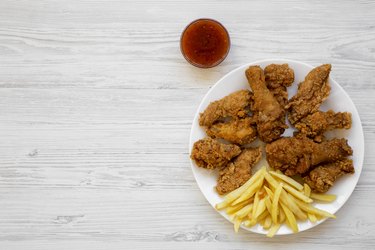Can I Coat My Beef With Cornstarch Instead of Flour

Cornstarch is the key ingredient for crunchy Korean-style fried chicken.
Image Credit: Liudmyla Chuhunova/iStock/GettyImages
If you're only using your cornstarch to thicken sauces or as a fun activity to entertain your kids, then you're not utilizing all the benefits of this kitchen cupboard staple. Chicken with cornstarch coating improves the crispness of your breaded or battered chicken.
The Science of Cornstarch
The silky fine white powder you use to thicken your gravy is made from the endosperm of the corn kernel, which makes up about 80 percent of the kernel and serves as a source of energy for the seed, according to the Corn Refiners Association (pg 7 of the PDF). During processing of the endosperm, the protein and fat are removed to create the starchy food additive.
The starch molecules in cornstarch — amylose and amylopectin — are responsible for its many functions as an ingredient and food additive. When you add a cornstarch slurry to your stir fry, these starch molecules swell and trap water as they heat up in your skillet, resulting in your thickened sauce.
As cornstarch cools, it creates a semi-solid gel and is responsible for creating the thick, creamy texture of pudding. The starch molecules in cornstarch also disperse or suspend other ingredients, acting as an emulsifying agent.
Though cornstarch serves many functions in food, it has very little nutritional value. According to the USDA, one cup of cornstarch has 488 calories, 117 grams of carbohydrates and 1.1 grams of fiber. The starch contains less than 1 gram of fat and protein and isn't a significant source of any vitamin or mineral.
Chicken With Cornstarch Coating
Thickening, gelling and emulsifying are certainly useful functions when you're making gravy or pudding, but you may be wondering how cornstarch can help your chicken. Well, like its many other uses, it all comes down to those starch molecules. The amylose and amylopectin in chicken with cornstarch coating serves many purposes.
When you coat your chicken with cornstarch, those starch molecules act as a barrier that holds in the juices and protects your meat from the heat of your oven, according to the American Meat Science Association. A cornstarch coating also absorbs some of the moisture in the chicken, before and during cooking. As noted, when heated with a liquid, cornstarch swells and holds onto water. However, as the heat in your oven increases, the water evaporates, leaving behind a rigid network of starch molecules and that distinct crispy texture.
Though you may consider using other starchy coatings, such as potato starch or wheat flour, chicken with cornstarch coating creates a crispier texture because it has a higher percentage of amylose. According to Utah State University Extension, amylose creates a firmer gel than amylopectin, which may result in a stronger, crispier coating.
Oven-Baked Cornstarch Fried Chicken
Fried chicken may be a family favorite, but it can be detrimental to your health, according to a January 2019 study published in BMJ. This prospective cohort study found that eating fried food frequently, specifically foods like fried chicken, increased risk of death from all causes, including heart disease.
You can still get the crispy texture you're looking for from your cornstarch fried chicken by baking it in the oven. Consider trying this LIVESTRONG.com recipe, Baked Chicken Nuggets. Before you dip your chicken nuggets in the batter, dredge them in cornstarch first. In addition to improving the crispiness of your nugget, the cornstarch also improves adhesion of the batter to your nugget, according to the American Meat Science Association.
You can also use cornstarch to liven up your baked chicken breasts. After seasoning your breasts with salt and pepper, cover them with cornstarch. Then bake them at 400 degrees Fahrenheit for 25 to 40 minutes, or until your chicken has reached an internal temperature of 165 F.
If you prefer breaded chicken, make a cornstarch batter to improve the crispness of your baked and breaded chicken. Just add cornstarch to your favorite chicken batter recipe and bake it in the oven.
Source: https://www.livestrong.com/article/459414-how-to-use-cornstarch-to-coat-chicken/
0 Response to "Can I Coat My Beef With Cornstarch Instead of Flour"
Post a Comment